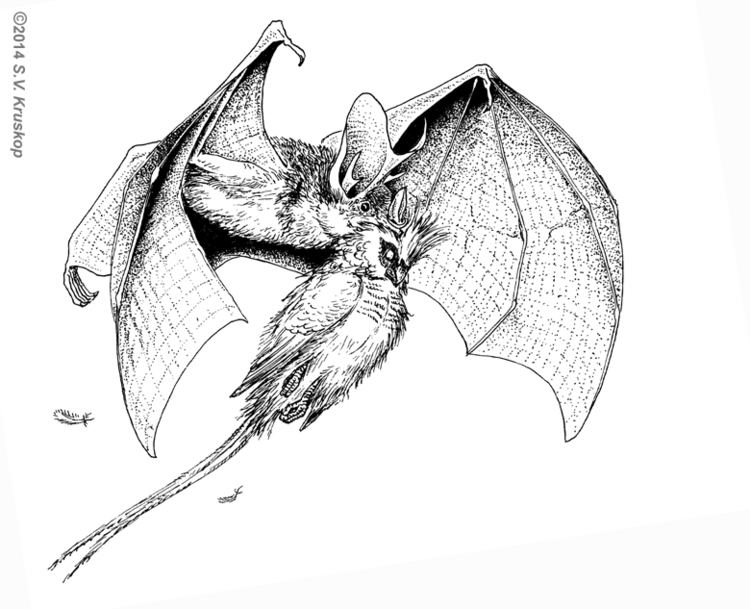Rank Genus | Phylum Chordata Order Bat | |
 | ||
Similar Bat, Archaeonycteris, Palaeochiropteryx, Icaronycteris, Megadermatidae | ||
Necromantis i now walk into the wild
Necromantis is an extinct genus of bat from the Eocene of France and Tunisia. Its fossils are found in the Quercy Phosphorites Formation and the Djebel Chambi, specimens of Necromantis are notable for their large size and specialization towards a predatory lifestyle.
Contents
Necromantis i now walk into the wild
History
The type species, N. adhicaster, was first described by A. Weithofer in 1887 on the basis of fragmentary fossils from the Eocene deposits of the Quercy Phosphorites Formation. Weithofer did not designate a type specimen, simply describing a lower jaw.
This material was later described in more detail by Pierre Revilliod in 1920, offering the holotype the number QW627. He described additional material, and classified it within five species: N. adhicaster, N. gerzei, N. marandati, N. planifrons and N. grandis.
More recently, E. Maitre has described the fossils in more detail. N. grandis and N. planifrons have been considered indistinguishable from N. adhicaster, but N. gerzei and N. marandati may be distinct enough to retain their respective statuses as distinct species.
Several indeterminate bat fossils in France may belong to Necromantis. Currently, only jaws and skulls are known, with a single humerus known as a postcranial remain.
More recently, Necromantis fragmentatum has been found in the Late Eocene deposits of Djebel Chambi, Tunisia. This north african species is known from several isolated teeth.
Description
Necromantis adhicaster has a skull length of about 32 mm and an estimated weight of 47 g, making it one of the largest bats in the Quercy Formation. Due to the lack of postcranial remains aside from a humerus, its exact wingspan is unclear. The other two species are smaller in size, and possess several differences in regards to the trigon and cingulum.
As noted by most researchers, Necromantis is unique among extinct and extant bats due to the sheer robustness of its jaws and skull. Its jaws are rather short and broad, bearing proportionally large teeth. The mandible is deep and thick and bears deep fossae; combined with the presence of a wide zygoma and a high-positioned condyle, it suggests that Necromantis had large, well developed masseters. The teeth themselves are strongly convergent with those of carnivoran mammals, bearing carnassial-like M1 and M2. The sagittal crest was tall, though less so than some other carnivorous bats like Vampyrum spectrum or Macroderma gigas
Biology
Necromantis has a strong negative tilting of the head, a characteristic thought to correlate with nasal-emission echolocation in bats, as seen in forms like megadermatids and phyllostomids, though it is not clear if Necromantis had a nose-leaf, too.
Its powerful jaws, combined with the specialised dentition, strongly suggest that Necromantis was a carnivore, feeding primarily on other vertebrates. The shearing teeth and strong masseters suggest that it was more specialised to grind and crush flesh and bone than other bat species. In particular, the angular process of the dentary implies that crushing force was much more important than the width of gape, unlike modern predatory bats.
Due to its large eyes and expanded petrosals, Necromantics might have hunted like modern megadermatids and phyllostomids, relying on low frequency-echolocation and passive listening. Such bats inspect their surroundings from a perch, locate vertebrate prey like birds and mammals visually and by sound, and ambush it, killing it by biting at the back of the head.
Another possibility suggested was that it was a scavenger, which is what prompte Weithofer to name it "death-eater".
Relationships
Currently, Necromantis is listed as incertae sedis. Weithofer originally classified it as a megadermatid, and Riviliod later as a phyllostomid, but similarities to either clade were ultimately deemed to be inconclusive and likely derived from convergent evolution. More recently, a relationship with emballonurid bats has been proporsed, possibly as a basal member descended from the early Eocene radiation of this clade, but currently this is inconclusive as well.
The more recent consensus is a position in Rhinolophoidea.
Ecology
Necromantis occurs in the Quercy Formation deposits estimated to date from the Middle to Late Eocene, 44-36 million years ago. The regional climate is thought to have been tropical in nature, marked by dense rainforests. Much like modern equatorial forests, the Quercy Formation bears a massive diversity in bat species; though the overall diversity of the region is thought to be incomplete, there are representatives of the still-extant Vespertilionidae, Molossidae, Hipposideridae and Emballonuridae (the former two still occur in Europe), as well as the now extinct Palaeochiropterygidae and Mixopterygidae.
